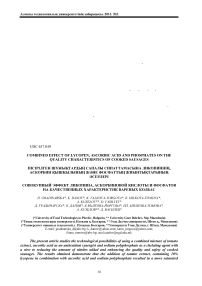Combined effect of lycopen, ascorbic acid and phosphates on the quality characteristics of cooked sausages
Автор: Gradinarska D., Danov K., Valkova-yorgova K., Milkova-tomova Il., Kuzelov A., Vasilyev D.
Журнал: Вестник Алматинского технологического университета @vestnik-atu
Рубрика: Техника и технологии
Статья в выпуске: 5 (101), 2013 года.
Бесплатный доступ
The present article studies the technological possibilities of using a combined mixture of tomato extract, ascorbic acid as an antioxidant synergist and sodium polyphosphate as a chelating agent with a view to reducing the amount of nitrites added and enhancing the quality and safety of cooked sausages. The results obtained demonstrate that the addition of tomato extract, containing 10% lycopene in combination with ascorbic acid and sodium polyphosphate resulted in a more saturated red colour and slowed the processes which induced lipid peroxidation reactions, reduce greatly the added nitrite amount and contributed to improved overall quality of structureless cooked sausage.
Sausages, lycopene, ascorbic acid, polyphosphate, quality
Короткий адрес: https://sciup.org/140205014
IDR: 140205014 | УДК: 637.049
Текст научной статьи Combined effect of lycopen, ascorbic acid and phosphates on the quality characteristics of cooked sausages
In recent years the meat industry has demonstrated a marked tendency towards focusing experts’ attention on the manufacture of products having the desired sensory character-ristics, origin and composition which are natural to the maximum extent possible, with emphasis on enhanced safety and wholesomeness. According to the WHO recommendations, considerable research has been conducted on the possibilities of using natural preservatives, colourants and flavours in food that would partially or fully replace the synthetic ones used so far [1]. At the same time, the addition of nitrites, nitrates and colourants for the purpose of improving the colour or imparting a desired colour to finished products is common practice in meat product manufacture [2-4].
The ongoing importance of the food quality and safety issue as well as the lack of sufficient evidence of the harmlessness of the colourants currently used, including carmine [56], has created a lasting interest in new, alternative sources of natural colourants. Lycopene is one of the most popular natural pigments approved as a food additive in the food industry and valued for its antioxidant properties. The synergistic antioxidant effect between lipophilic lycopene and hydrophilic vitamin C and ascorbate in relation to biological systems has also been proved [7-8]. Provoked by the search for both safe and healthy meat products, research and development activities are currently focused on finding alternative substances for nitrite replacement and reduction without any negative consequences on the technological process or the qualitative and quantitative properties of the end product.
The aim of the present study was to investigate the technological possibilities of using a combined mixture of tomato extract, ascorbic acid (an antioxidant synergist) and sodium polyphosphate (a chelating agent) with a view to reducing the amount of nitrites added and enhancing the quality and safety of cooked sausages.
Materials and methods
Dry tomato extract containing 10% lycopene was used as a natural product in this study. The extract was obtained by grinding the tomatoes and separating the juice, then subjecting the tomato cellulose mass to ethyl acetate extraction. The end product was obtained after solvent removal via vacuum evaporation at 40-60°С. The lycopene quantity was determined by HPLC and absorption measurement at λ 440 nm. For the preparation of the test samples, the tomato extract quantity was re- calculated on the basis of lycopene quantity added to 1 kg of meat batter.
Figure 1 shows a schematic representation of the experimental setup.
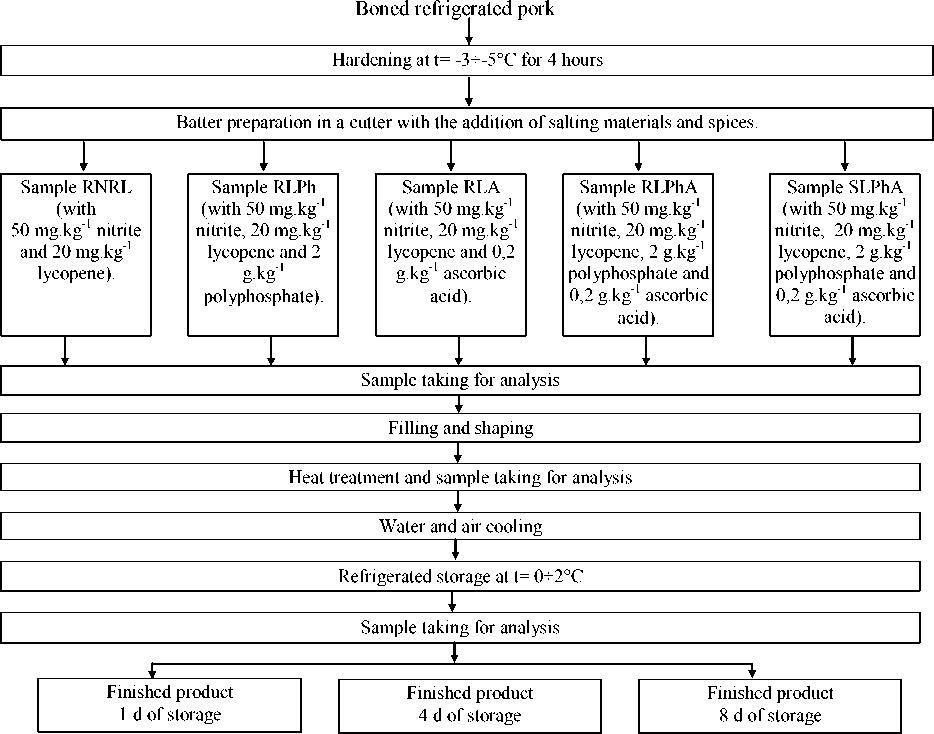
Figure 1 - Experimental setup.
The experiments were conducted using structureless sausage according to the BDS 12783 recipe and technological instruction for the production of Strandzha frankfurters: 30% lean pork, 70% semi-fat pork, 2.2% sodium chloride, 0.1% sugar, 0.4% white pepper, and 0.1% nutmeg. For the preparation of the samples, sodium nitrite, ascorbic acid, sodium polyphosphate and lycopene were added in the amounts shown in the experimental setup in Fig. 1. During cutting, flaky ice was added in a quantity equal to 30% of the meat mass weight. The samples were prepared at the Training and Production Facility of the Meat and Fish Technology Department. Boned refrigerated pork with рН = 6.13 ± 0.15 bought at retail stores was used for the purpose of the study.
The meat batter was stuffed into artificial polyamide casings. After shaping, the sausages were heat-treated as follows: 1) 55°С chamber temperature for 10 min; 2) 65°С chamber temperature for 15 min; 3) 75°С chamber temperature for 15 min; and 4) 80°С chamber temperature until the temperature in the centre of the sausage reached 72°С. The cooked sausages were cooled under running water for 15 ÷ 20 min until the temperature of individual sausages was equal to the ambient temperature. The refrigerated sausages were stored in a cooling chamber at 1 ÷ 0°С until the time of the analyses.
For evaluation of the effect of lycopene, ascorbic acid and sodium polyphosphate upon the quality indices of the cooked sausage, the changes in pH, colour, residual nitrites, peroxide value (POV) and sensory characteristics were monitored.
The pH values of the samples were determined using an MS 2004 pH meter (Microsyst, Bulgaria). The residual nitrite quantity in the cooked sausage samples studied was evaluated spectrophotometrically using a
UV/VIS spectrophotometer (Camspec, model М 550) according to BDS EN 12014-3 [9]. The colour characteristics of the tested sausage samples were determined using a Minolta Chroma Meter (model CR 410, Osaka, Japan) in the CIE Lab system, where L* was brightness, a* was the red colour component and b* was the yellow colour component. The measurement was conducted using illuminant C and 2° standard observation angle. All measurements were taken five times in non-overlapping zones, and the mean values and standard deviation were calculated. The data related to а* and b* were used for the calculation of colour saturation h according to the formula h = tan - 1 ( b * / a * ) x (180/ n ) , and the colour of hue C according to the formula C = V a *2 + b *2 .
The sensory evaluation of the samples was made on the 4th day of refrigerated storage at a temperature of 0 ÷ 4°С. The analysis was performed by a five-member tasting panel along a hedonic scale. For each of the indices evaluated, i.e. appearance, cut colour, taste, smell and texture, a scale of 1 to 5 was used, 1 being the dislike extremely, and 5 the like extremely evaluation of the respective attribute.
StatPlus 2009 software was used for the statistical processing of the results.
Results and discussion
The analysis of the data related to the pH values of the cooked sausages (Table 1) showed that the changes in all five samples followed a similar trend. It was found that during the technological process, after heat treatment (singeing and boiling) in particular, the active acidity of all sausage samples increased, reaching maximum values on the first day of the finished product storage. During refrigerated storage, there was a clear tendency towards a decrease in pH values.
Table 1 - Changes in the рН values during the technological process and refrigerated storage of cooked sausages.
|
Sample |
During manufacture |
During refrigerated storage |
|||
|
Meat batter |
After heat treatment |
1 d |
4 d |
8 d |
|
|
RNRL |
6.09± 0.01 |
6.34± 0.01 |
6.35 ±0.01 |
6.25 ±0.03 |
6.03 ±0.02 |
|
RLPh |
6.12± 0.01 |
6.36 ±0.02 |
6.36 ±0.01 |
6.30 ±0.05 |
6.18 ±0.01 |
|
RLA |
5.98±0.00 |
6.22 ±0.03 |
6.24 ±0.02 |
6.12 ±0.02 |
5.97 ±0.03 |
|
RLPhA |
6.04± 0.02 |
6.32 ±0.05 |
6.34 ±0.01 |
6.26 ±0.00 |
6.09 ±0.02 |
|
SLPhA |
6.05 ±0.01 |
6.32 ±0.03 |
6.34 ±0.02 |
6.27 ±0.01 |
6.13 ±0.02 |
After 8 days of refrigerated storage, the lowest value was observed in the RLA sample, and the highest value in the RLPh sample, or 5.97±0.03 and 6.18±0.01 respectively (Table 1). In samples RLPhA and SLPhA no statistical differences (р>0.01) were observed in the pH values during the manufacture and storage of cooked sausages. This confirmed our previous findings that the addition of lycopene did not affect active acidity. Phosphate addition to the batter had no significant effect on the pH value of the samples either (р>0.05), whereas the addition of ascorbic acid (sample RLA) had considerable influence on pH (p < 0.05).
A reduction in the residual nitrite quantity was established in all sausage samples after heat treatment and during storage (Fig. 1).
The addition of ascorbic acid (sample RLA, SLPhA and RLPhA) exerted significant influence on the reduction of the residual nitrite quantity in the meat batter, which has been reported by other authors as well (Gibson et al, 1984???). The comparison of the data related to samples SLPhA and RLPhA showed that the addition of lycopene in 20 mg.kg-1 and 40 mg.kg-1 amounts had a much weaker effect on residual nitrite compared to the addition of ascorbic acid.
After the heat treatment and during the storage of the sausages, the peroxide value increased in all samples studied (Fig. 2). The lowest value during the manufacture and storage of the samples was established for the SLPhA sample.
The changes established in the peroxide value of cooked sausage samples showed that the combined effect of lycopene, ascorbic acid and polyphosphate contributed to a delay in the formation of primary lipid peroxidation products during cooked sausage processing and storage.
The results of the spectrophotometric evaluations of colour in individual samples during storage have been presented in Fig. 3.
a
b
c
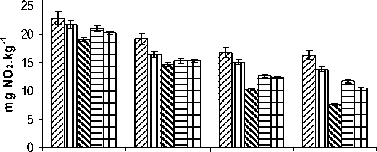
0 RNRL
□ RLPh a RLA
Q RLPhA
□ SLPhA after heat 1d 4d
8d treatment
Time, d
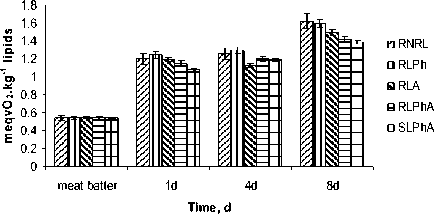
Figure 2 - Changes in the peroxide value in cooked sausages manufactured with the addition of lycopene ascorbic acid and polyphosphate.
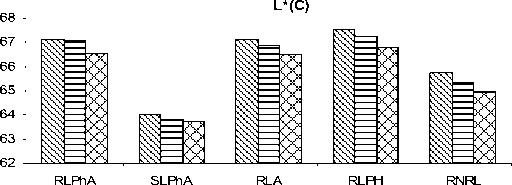
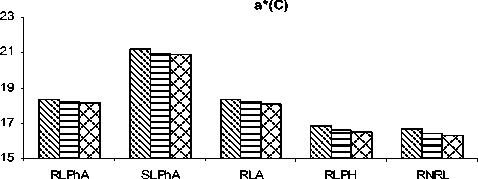
Q 1d
□ 4d
□ 8d
в 1d
□ 4d в 8d

Figure 3 - Changes in the colour indices of cooked sausage samples during storage (on the 1st, 4th and 8th day): (a) L* values, (b) a* values, and (c) b* values.
The comparison of samples RLA, RLPh, and RLPhA to sample RNRL along index L*(C) on the first day of storage showed that the addition of ascorbic acid and/or sodium polyphosphate led to an increase in colour brightness by 1.36, 1.7 and 1.39 units respectively. The analysis of the data on samples RLPhA and SLPhA confirmed the trend found in one of our previous experiments (our paper) that the increase in the quantity of lycopene added reduced the colour brightness value. During refrigerated storage, index L*(C) decreased slightly in all samples (Fig. 3a).
In all samples studied, differences in the red component values were found except for the RLA and RLPA samples, where these values were statistically indistinguishable both on the 1st day and during storage. The red colour development in the sausage samples was mainly due to the addition of tomato extract containing 10% lycopene, whereas the ascorbic acid addition played a secondary role by stabilising the sausage colour during refrigerated storage (Fig. 3b).
The analysis of the results obtained on the yellow colour component values in the cooked sausage samples (Fig. 3c) showed that the lycopene quantity had a significant effect both on а* and b*.
Nevertheless, after its addition in combination with ascorbic acid, statistically lower b*(С) values were measured in samples RLA and RLPhA compared to the lycopene-free sample (RNRL).
For a more comprehensive study of the effect of lycopene, ascorbic acid and/or sodium phosphate addition, hue colour h(С) (Fig. 4 b) and colour intensity C(С) (Fig. 4 а) were also calculated.
a
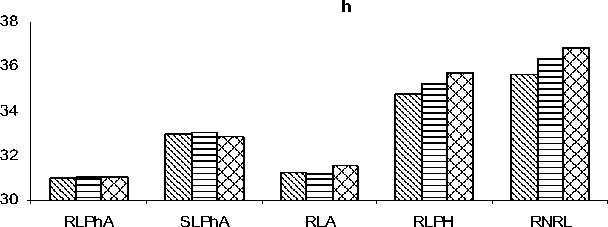
Q 1d
□ 4d
□ 8d
b
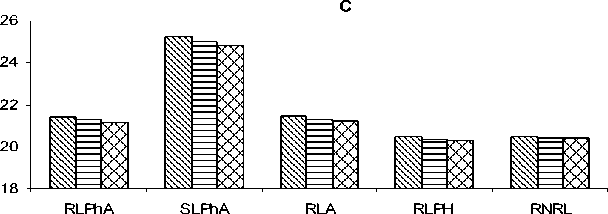
в 1d
□ 4d
□ 8d
Figure 4 - Changes in the h values (a) and C values (b) of the cooked sausage samples during storage (on the 1st, 4th and 8th day).
The trends observed for colour saturation С in the samples studied were inversely proportional to those for colour brightness (L*) and could be arranged in the following order: SLPhA > RLA, RLPhA > RNRL, RLPh (Fig. 4b).
Fig. 4a shows that the lowest h(С) values were recorded in samples SLPhA, RLPhA and RLAin the following order: RLPhA < RLA< SLPhA. With regard to the fact that higher Н are indicative of a colour shift towards the yellow domain, the most saturated red colour was observed in RLPhA and RLA.
The analysis of the results provided a basis for a conclusion that the combined addition of lycopene and ascorbic acid contributed to a more saturated red colour, which was also confirmed by the results of the sensory analysis of appearance and colour.
The analysis of the data related to the appearance and colour of the cut surface of the samples made with the addition of ascorbic acid showed that the latter had a considerable effect on these two indices (Fig. 5). The highest colour evaluation was given to sample RLPhA, followed by samples RLA and SLPhA.
The lower cut surface appearance and colour values in the other two samples (RNRL and RLPh) were probably due to the weaker colour formation processes during singeing and boiling, which correlated with the results of the objectively measured colour indices in the cooked sausage samples. The opposite trend was observed with the texture index.
The comparative analysis of the mean taste and smell evaluations of samples RLPhA and SLPhA demonstrated that the combination of ascorbic acid, phosphate and lycopene had a positive effect on them. This could be attributed to their synergistic effect with regard to the autooxidation of lycopene and fats in the samples that could lead to changes in the taste and smell of cooked sausages during storage.
Global
Taste
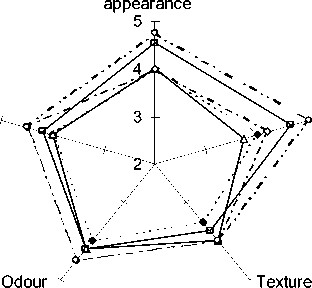
Colour
- - - ♦- - - RNRL —д RLPh -о- SLPhA
--Q RLA — - о— - RLPhA
Figure 5 - Sensory evaluation of cooked sausage samples.
The highest overall evaluation was given to sample RLPhA: 4.55 along a 5-grade scale. The total scores for samples RNRL and RLPh were statistically indistinguishable (p>0.05) and the lowest compared to the other samples. Midrange total scores, which were also statistically indistinguishable (p>0.05), were given to samples SLPhA and RLA.
Conclusion
The addition of lycopene (20 mg.kg -1) in combination with ascorbic acid and sodium polyphosphate contributed to improved overall quality of structureless cooked sausages of the Strandzha frankfurter type. The combined addition of lycopene, ascorbic acid and polyphosphate resulted in a more saturated red colour and slowed the processes which induced chain lipid peroxidation reactions during the processing and storage of cooked sausages. The combination of lycopene in a 20 mg.kg-1 quantity with ascorbic acid and sodium polyphosphate can be efficiently used to reduce greatly the added nitrite amount in cooked sausage production, which is a serious prerequisite for the manufacture of a finished product characterised by improved sensory characteristics and chemical safety as regards residual nitrites.
REFFENCES
-
1. World Health Organization. (2010). Food and Agriculture Organization of the United Nations. Evaluation of certain food additives. Seventy-first report of the Joint FAO/WHO Expert Committee on Food Additives. World Health Organ Tech Rep Ser.;(956):1-80
-
2. Brewer, M.S., Mckeith, F.K. (1999). Consumer – rated quality characteristics as related to purchase intent of fresh pork. //Journal of Food Science, 64. Р. 171 – 174 .
-
3. Bryhni, E.A., Byrne, D.V., Rchdbotten, M., et al. (2002). Consumer perceptions of pork in Denmark, Norway and Sweden. //Food Quality and Preference, 13. -Р. 257 – 266.
-
4. Francis, F.J. (2005). Quality as influenced by color. //Food Quality and Preference, 6. –Р. 149 – 155.
-
5. Baldwin J. L., Chou, A.H., Solomon, W. R. (1997). Popsicle-induced anaphylaxis due to carmine dye allergy. Ann. Allergy Asthma Immunol. 79. -Р. 415–419.
-
6. Wüthrich, B., Kagi, M. K., and Stucker, W. (1997). Anaphylactic reactions to ingested carmine (E120). Allergy 52. –Р. 1133–1137.
-
7. Young, A. J. and Lowe, G. M. (2001). Antioxidant and prooxidant properties of cartenoids. Arch. Biochem. Biophys., 385.
-
8. Shixian, Q. Dai, Y. Kakuda, Y. Shi, J. Mittal, G. Yeung, D. Jiang, Y. Synergistic anti-oxidative effects of lycopene with other bioactive compounds. Food Rev. Int. 2005, 21. –Р. 295-311.
-
9. BDS EN 12014-3:2005. Foodstuffs – Determination of nitrate and/or nitrite content – Part 3: Spectrometric determination of nitrate and nitrite content of meat products after enzymatic reduction of nitrate to nitrite. Identical with EN 12014-3:2005, CEN, Bruxelles, Belgium.
-
10. Bligh, E.G., Dyer, W.J. (1959). A rapid method of total lipid extraction and purification. //Can. J.Biochem. Physiol. 37. –Р. 911-917.
Список литературы Combined effect of lycopen, ascorbic acid and phosphates on the quality characteristics of cooked sausages
- World Health Organization. (2010). Food and Agriculture Organization of the United Nations. Evaluation of certain food additives. Seventy-first report of the Joint FAO/WHO Expert Committee on Food Additives. World Health Organ Tech Rep Ser.;(956):1-80
- Brewer, M.S., Mckeith, F.K. (1999). Consumer -rated quality characteristics as related to purchase intent of fresh pork.//Journal of Food Science, 64. Р. 171 -174.
- Bryhni, E.A., Byrne, D.V., Rchdbotten, M., et al. (2002). Consumer perceptions of pork in Denmark, Norway and Sweden.//Food Quality and Preference, 13. -Р. 257 -266.
- Francis, F.J. (2005). Quality as influenced by color.//Food Quality and Preference, 6. -Р. 149 -155.
- Baldwin J. L., Chou, A.H., Solomon, W. R. (1997). Popsicle-induced anaphylaxis due to carmine dye allergy. Ann. Allergy Asthma Immunol. 79. -Р. 415-419.
- Wüthrich, B., Kagi, M. K., and Stucker, W. (1997). Anaphylactic reactions to ingested carmine (E120). Allergy 52. -Р. 1133-1137.
- Young, A. J. and Lowe, G. M. (2001). Antioxidant and prooxidant properties of cartenoids. Arch. Biochem. Biophys., 385.
- Shixian, Q. Dai, Y. Kakuda, Y. Shi, J. Mittal, G. Yeung, D. Jiang, Y. Synergistic anti-oxidative effects of lycopene with other bioactive compounds. Food Rev. Int. 2005, 21. -Р. 295-311.
- BDS EN 12014-3:2005. Foodstuffs -Determination of nitrate and/or nitrite content -Part 3: Spectrometric determination of nitrate and nitrite content of meat products after enzymatic reduction of nitrate to nitrite. Identical with EN 12014-3:2005, CEN, Bruxelles, Belgium.
- Bligh, E.G., Dyer, W.J. (1959). A rapid method of total lipid extraction and purification.//Can. J.Biochem. Physiol. 37. -Р. 911-917.

